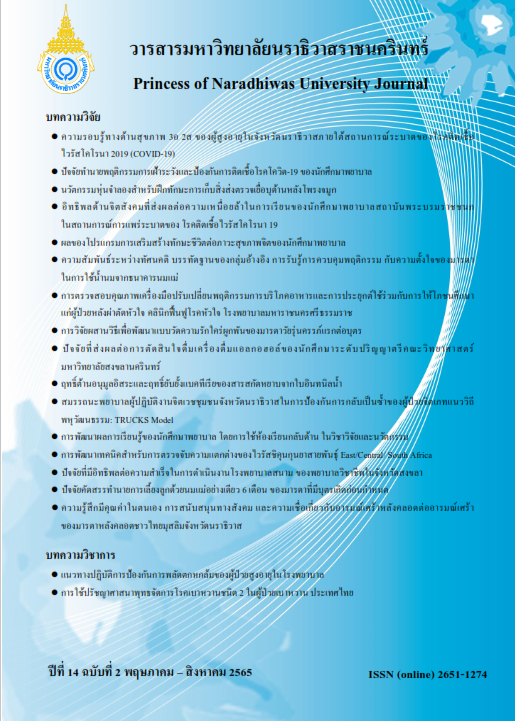ปัจจัยทำนายพฤติกรรมการเฝ้าระวังและป้องกันการติดเชื้อโรคโควิด-19 ของนักศึกษาพยาบาล
คำสำคัญ:
ปัจจัยทำนายพฤติกรรม, การเฝ้าระวังและป้องกันการติดเชื้อโรคโควิด-19, นักศึกษาพยาบาลบทคัดย่อ
การวิจัยเชิงทำนายนี้มีวัตถุประสงค์เพื่อศึกษาปัจจัยทำนายพฤติกรรมการเฝ้าระวังและป้องกันการติดเชื้อโรคโควิด-19 ของนักศึกษาพยาบาล กลุ่มตัวอย่างคือ นักศึกษาพยาบาล 204 คน คำนวณขนาดตัวอย่างโดยใช้ G*Power 3.1.9.7 และสุ่มตัวอย่างแบบแบ่งชั้นภูมิ เครื่องมือที่ใช้ ประกอบด้วย 3 ส่วน คือ 1) แบบทดสอบความรู้เกี่ยวกับโรค การเฝ้าระวังและป้องกันการติดเชื้อโรคโควิด-19 2) แบบสอบถามปัจจัยที่เกี่ยวข้องกับพฤติกรรมการเฝ้าระวังและป้องกันการติดเชื้อโรคโควิด-19 และ 3) แบบสอบถามพฤติกรรมการเฝ้าระวังและป้องกันการติดเชื้อโรคโควิด-19 การวิเคราะห์ข้อมูลโดยใช้สถิติเชิงพรรณนา ได้แก่ ความถี่ ร้อยละ ค่าเบี่ยงเบนมาตรฐาน และการวิเคราะห์ถดถอยแบบขั้นตอน ผลการวิจัยพบว่า เจตคติ การรับรู้ประโยชน์ของการป้องกันการติดเชื้อโรคโควิด-19 แรงสนับสนุนทางสังคม ความรู้เกี่ยวกับโรค การเฝ้าระวังและป้องกันการติดเชื้อโรคโควิด-19 สามารถร่วมกันทำนายพฤติกรรมการเฝ้าระวังและป้องกันการติดเชื้อโรคโควิด-19 ของนักศึกษาพยาบาล ได้ร้อยละ 38.7 อย่างมีนัยสำคัญทางสถิติที่ระดับ .05 (R2=.387, p<.05) การรับรู้ประโยชน์ของการป้องกันการติดเชื้อโรคโควิด-19 (Beta =.327,p<.05) และเจตคติต่อโรคและการเฝ้าระวังป้องกันโรค
โควิด-19 (Beta =.247, p<.05) เป็นตัวแปรสำคัญที่มีอิทธิพลทำนายพฤติกรรมการเฝ้าระวังและป้องกันการติดเชื้อโรคโควิด-19
เอกสารอ้างอิง
Albaqawi, H.M., Alquwez, N., Balay-Odao, E., Bajet, J.B., Alabdulaziz, H., Alsolami, F., … Cruz, J. P. (2020). Nursing students' perceptions, knowledge, and preventive behaviors toward COVID-19: A multi-university study. Frontiers in Public Health, 8(8), 1-9.
Asemahagn, M.A. (2020). Factors determining the knowledge and prevention practice of healthcare workers towards COVID-19 in Amhara region, Ethiopia: a cross-sectional survey. Tropical Medicine and Health, 48(1), 1-11.
Barisri, J., Sukperm, K., Phavaputanont Na Masarakham, N., Nilphai, P., & Lammana, P. (2020). COVID-2019 prevention behaviors (COVID-2019) students of Roi-Et Rajabhat University. Journal of Legal Entity Management and Local Innovation, 6(6), 38-45.
Bashirian, S., Jenabi, E., Khazaei, S., Barati, M., Karimi-Shahanjarini, A., Zareian, S., ... & Moeini, B. (2020). Factors associated with preventive behaviours of COVID-19 among hospital staff in Iran in 2020: an application of the protection motivation theory. Journal of Hospital Infection, 105(3), 430-433.
Best, J.W., & Kahn, J.V. (2006). Research in education. Boston: Pearson Education.
Brown, H.D. (2004). Language assessment: principles and classroom practices. White Plains: Pearson Education.
Choi, J.S., & Kim, J.S. (2016). Factors influencing preventive behavior against Middle East Respiratory Syndrome-Coronavirus among nursing students in South Korea. Nurse Education Today, 40, 168-172.
Cohen, J. (1992). A power primer: quantitative methods in psychology. Psychological Bulletin, 112(1), 155-159.
Department of Disease Control, Ministry of Public Health. (2021). Use of D-M-H-T-T-A principle: Safety sure and warm-heartedly. Retrieved June 21, 2021, from https://ddc.moph.go.th/brc/ news.php?news=18373&deptcode=brc
Dhouib, W., Maatoug, J., Ayouni, I., Zammit, N., Ghammem, R., Fredj, S.B., & Ghannem, H. (2021). The incubation period during the pandemic of COVID-19: a systematic review and meta-analysis. Systematic Reviews, 10(1), 1-14.
Elhadi, M., Msherghi, A., Alsoufi, A., Buzreg, A., Bouhuwaish, A., Khaled, A., … Elgzairi, M. (2020). Knowledge, preventive behavior and risk perception regarding COVID-19: a self-reported study on college students. The Pan African Medical Journal, 35(Suppl 2), 75.
Faul, F., Erdfelder, E., Lang, A.G., & Buchner, A. (2007). G* Power 3: A flexible statistical power analysis program for the social, behavioral, and biomedical sciences. Behavior Research Methods, 39(2), 175-191.
Green, L.W. & Kreuter, M.W. (2005). Health program planning: An educational and ecological approach. New York: McGraw-Hill.
Haleem, A., Javaid, M., & Vaishya, R. (2020). Effects of COVID-19 pandemic in daily life. Current medicine research and practice, 10(2), 78-79.
Kampf, G., Todt, D., Pfaender, S., & Steinmann, E. (2020). Persistence of coronaviruses on inanimate surfaces and their inactivation with biocidal agents. Healthcare Infection Society, 104(3), 246-251.
Khare, N., Jha, M., Mathur, R., & Jha, A.K. (2020). Data analysis for COVID-19. The International Journal of Analytical and Experimental Modal Analysis, 12(5), 960-974.
Lake, M.A. (2020). What we know so far: COVID-19 current clinical knowledge and research. Clinical Medicine, 20(2), 124.
Morasakul, B. & Punthasee, P. (2021). Knowledge and prevention behaviors regarding COVID-19 among the first-year nursing students of Saint Theresa International College and Saint Louis College. Regional Health Promotion Center 9 Journal, 15(37), 179-195.
Nadeem, M.S., Zamzami, M.A., Choudhry, H., Murtaza, B.N., Kazmi, I., Ahmad, H., & Shakoori, A. R. (2020). Origin, potential therapeutic targets and treatment for coronavirus disease (COVID-19). Pathogens, 9(4), 307.
Ongarj, P. & Ungcharoen, R. (2021). Self-protection behavior of COVID-19: A case study of students at Kasetsart University, Chalermphrakiat campus, Sakon Nakhon province. Public Health Policy & Law Journal, 7(1), 87-102.
Singkun, A., Patiwikriwong, P., Chainapong, K., & Weerakhachon, P. (2020). Factors associated with coronavirus 2019 (COVID-19) prevention behaviors among health sciences students of a higher education institution in Yala province, Thailand. Walailak Journal of Science and Technology, 17(9), 967-978.
Sakdapat, N. (2021). Psychosocial factors related to the COVID-19 prevention behaviors of undergraduate students. Warasan Phuettikammasat, 27(2), 39-62.
Singweratham, N., Thaopan, W.W., Nawsuwan, K., Pohboon, C. & Surirak, S. (2020). Perception and preventive behaviors on the coronavirus disease-2019 (COVID-19) among dental nurses under the Ministry of Public Health. Journal of Bamrasnaradura Infect, 14(2), 104-115.
WHO. (2020a). Transmission of SARS-CoV-2: Implications for infection prevention precautions. Retrieved June 21, 2021, from https://www.who.int/news-room/commentaries/detail/ transmission-of-sars-cov-2-implications-for-infection-prevention-precautions
WHO. (2020b). Infection prevention and control during health care when COVID-19 is suspected: interim guidance, 19 March 2020 (No. WHO/2019-nCoV/IPC/2020.3). World Health Organization.
WHO. (2021a). WHO coronavirus (COVID-19) dashboard. Retrieved September 25, 2021, from https://covid19.who.int/
WHO. (2021b). Preventing and mitigating COVID-19 at work. Retrieved September 25, 2021, from https://www.who.int/publications/i/item/considerations-in-adjusting-public-health-and-social-measures-in-the-context-of-covid-19-interim-guidance
ไฟล์ประกอบ
เผยแพร่แล้ว
รูปแบบการอ้างอิง
ฉบับ
ประเภทบทความ
สัญญาอนุญาต
ลิขสิทธิ์ (c) 2022 วารสารมหาวิทยาลัยนราธิวาสราชนครินทร์

อนุญาตภายใต้เงื่อนไข Creative Commons Attribution-NonCommercial-NoDerivatives 4.0 International License.




